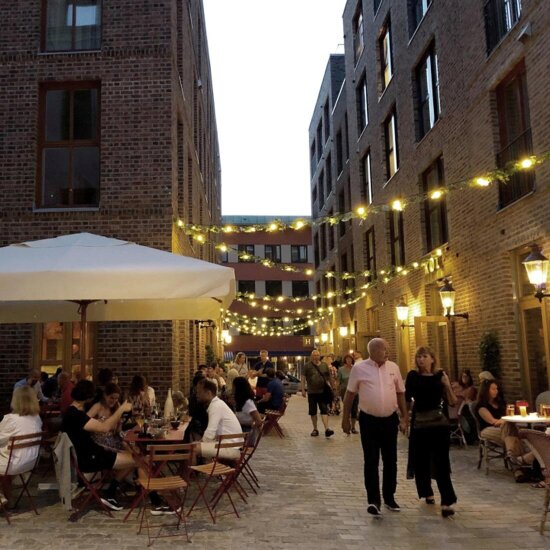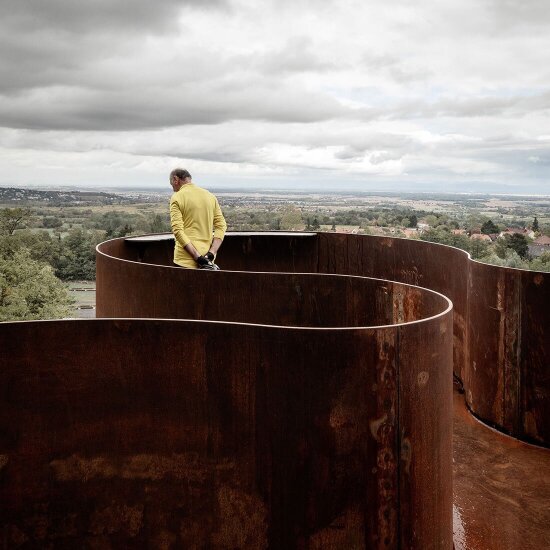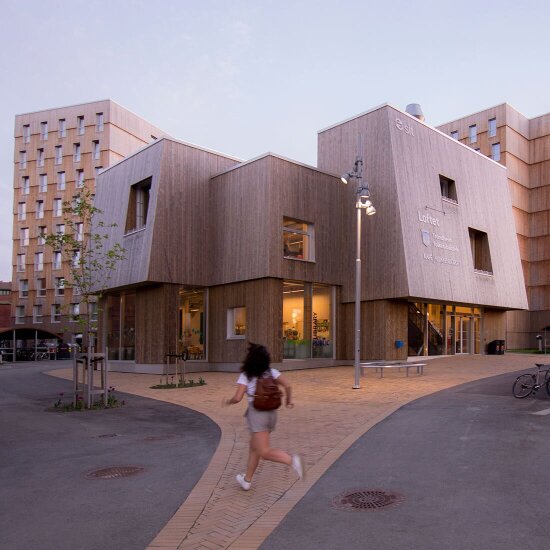At the end of the 1890s, the area around Nygaardsplassen in Fredrikstad was full of traditional townhouses built around rear courtyards, with plots that stretched down to the river bank. Between the rear courtyards were alleys and passages, and the area was always bustling.
In the 1970s, many of the old buildings were demolished and new commercial buildings were built around the plaza. People moved out, and offices and faceless businesses moved in. The urban life around Nygaardsplassen disappeared.Read more about design and architecture in Norway >>
Getting people to slow down
Property developer Cityplan wanted to recreate the vibrant urban space that had once been there. They hired the architects Mad to turn this vision into reality. Together they have created a new urban space, inspired by the formerly vibrant local culture, and with a historic nod to the brickwork tradition of Fredrikstad. The area is full of nooks and crannies, alleys and open plazas, warm brick façades and paved streets. The narrow streets encourage people to slow down, and make Nygaardsplassen a place where you want to linger and come back to.

Photo: Simon Øien
“Nygaardsplassen has had a major impact on the local community of Fredrikstad. It is a project that has made the local community even more proud of their city,” says Trond Elverum, civil architect MNAL of Mad Arkitekter.
The DOGA Award’s panel thinks that the project is a well-executed urban restoration that has won the hearts of the businesses, town planners and local people, and it particularly highlights good meeting places and friendly architecture as important qualities.
Connecting five villages
When the car took over from the railway as the means of transport between five villages in Alsace in France, the result was that fewer people enjoyed the area’s beautiful natural environment. There was also a lack of cycleways, which kept cycle tourists away. The local authorities wanted to do something about this.

Photo: Florent Michel @11h45
They hired Reiulf Ramstad Arkitekter, who joined forces with the French architects' office Parenthèse Paysage & Urbanisme to get started on the work of creating a hiking and cycling trail along the disused railway line. The result is the Chemin des Carrières – an 11 kilometre long hiking trail in Alsace that connects five villages.
Hiking trail has breathed life into the area
The close cooperation between architects, developer, local authorities and local businesses has played a vital role in the project’s warm reception by the locals. The project has brought unity and pride to the area, and has created favourable conditions for tourism and new businesses, meeting places and hiking opportunities, more environmentally-friendly transport and cleaner air.
“The project is not a building, but a series of physical objects brought together with a holistic approach. This is an enriching journey for residents and visitors alike. It is wonderful that it has brought these five villages together. We need a new approach in sparsely populated areas, so that young people will not only stay there, but will also come back”, says Reiulf Ramstad.
The panel for the DOGA Award for Design and Architecture calls the project exemplary because it shows how old structures can be given a new lease of life and contribute to local value creation.
Local heating and social interaction
Trondheim’s biggest student village, Moholt, was under construction from 2014–2019, and it includes accommodation for 632 students, a kindergarten, activity centre and local library.
When the student welfare organisation in Gjøvik, Ålesund and Trondheim (Sit) decided to build new student accommodation, they hired MDH Arkitekter. Together they had an ambition to establish a new best practice for sustainable student accommodation.
The result is a student village in which every building is a solid wood passive house, with energy supplied by a dedicated local heating plant. But there has also been an equal focus on human warmth. So there are plenty of good meeting venues and minimal use of corridors, which help to promote a sense of community and social interaction.

Photo: MDH Arkitekter
Honoured with DOGA’s highest award
“As a student welfare organisation, our aim is to provide good-quality, secure housing for students, with a particular focus on first-year students. Mental health is an issue for many people, and loneliness is an increasing problem among students,” explains Arvid Eriksen Skjervik, Sit’s head of projects and development.
Moholt 50I50 was given the DOGA Honours Award – a distinction that is given to projects that demonstrate a particularly outstanding design and architectural quality, and which make a major contribution to improving social, environmental and financial values.
Somewhere between home and work
In 2013, Lundhagem and Atelier Oslo were tasked with designing a new main library for Oslo in Bjørvika. Scenario Interiørarkitekter were given the job of furnishing it. In the summer of 2020, the doors finally opened on the city’s new house of literature.
“The way the interior designers and architects have addressed the challenges involved in the new main library has been amazing. The materials are excellent, there is plenty of variation, it is easy to feel at home,” says Merete Lie, head of department in Deichman Bjørvika.
And the visitor numbers show very clearly that people do feel at home there. The library has quickly become extremely popular, and Oslo’s residents and tourists have all flocked to the building and made frequent use of it.
“We have described it as the third place – somewhere between home and work – a place that feels welcoming and homely without being a home,” Lie elaborates.

Photo: Einar Aslaksen
A hub for the future
The panel for the DOGA Award for Design and Architecture says that Deichman Bjørvika has become the iconic and modern library that everyone hoped it would.
It is no mean feat to make such a large and complex building feel inclusive and almost intimate, and we have every reason to believe that the new main library will be a hub of knowledge and inspiration well into the future,” said the panel.